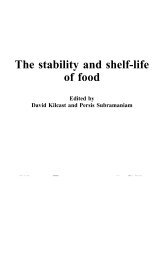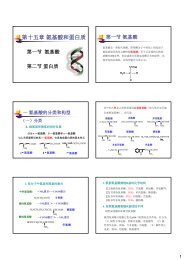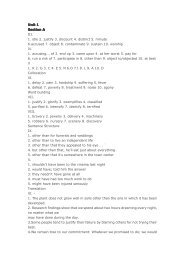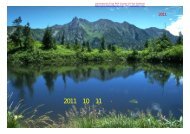Controlled Atmosphere Storage of Fruits and Vegetables, Second ...
Controlled Atmosphere Storage of Fruits and Vegetables, Second ...
Controlled Atmosphere Storage of Fruits and Vegetables, Second ...
Create successful ePaper yourself
Turn your PDF publications into a flip-book with our unique Google optimized e-Paper software.
4 Chapter 1The term controlled atmosphere storagewas not adopted in Britain until 1960 (Fidleret al., 1973). Smock also spent time with Kidd<strong>and</strong> West at the Ditton laboratory. The CAstorage work at Cornell included strawberries<strong>and</strong> cherries (Van Doren et al., 1941). Adetailed report <strong>of</strong> the findings <strong>of</strong> the Cornellgroup was presented in a comprehensive bulletin(Smock <strong>and</strong> Van Doren, 1941), whichgave the results <strong>of</strong> research on atmospheres,temperatures <strong>and</strong> varietal responses <strong>of</strong> fruit,as well as store construction <strong>and</strong> operation. Inaddition to the research efforts in Davis <strong>and</strong>Cornell, several other groups in the USA werealso carrying out research into CA storage.CA storage research on a variety <strong>of</strong> fruits <strong>and</strong>vegetables was described by Miller <strong>and</strong>Brooks (1932) <strong>and</strong> Miller <strong>and</strong> Dowd (1936).Work on apples was described by Fisher(1939) <strong>and</strong> Anon. (1941), work on citrus fruitby Stahl <strong>and</strong> Cain (1937) <strong>and</strong> Samisch (1937),<strong>and</strong> work on cranberries by Anon. (1941).Smock’s work in New York State Universitywas facilitated in 1953 with the completion <strong>of</strong>large new storage facilities designed specificallyto accommodate studies on CA storage.Commercial CA storage <strong>of</strong> apples in theUSA began in New York State with McIntosh.The first three CA rooms with a total capacity<strong>of</strong> 24,000 bushels were put into operation in1940, with Smock <strong>and</strong> Van Doren acting asconsultants. This had been increased to100,000 bushels by 1949, but the real expansionin the USA began in the early 1950s. Inaddition to a pronounced growth in commercialoperations in New York State, CA storeswere constructed in New Engl<strong>and</strong> in 1951, inMichigan <strong>and</strong> New Jersey in 1956, in Washington,California <strong>and</strong> Oregon in 1958, <strong>and</strong> inVirginia in 1959 (Dalrymple, 1967). A CA storefor Red Delicious was set up in Washingtonstate in the late 1950s in a Mylar tent, wheresome 1000 bushels were stored with goodresults. By the 1955/1956 season the total CAstorage holdings had grown to about 814,000bushels, some 684,000 bushels in New Yorkstate <strong>and</strong> the rest in New Engl<strong>and</strong>. In thespring <strong>of</strong> that year Dalrymple did a study <strong>of</strong>the industry in New York state <strong>and</strong> foundthat, typically, CA stores were owned by large<strong>and</strong> successful fruit farmers (Dalrymple,1967). The average total CA storage holdingsper farm were large, averaging 31,200 bushels<strong>and</strong> ranging from 7500 to 65,000 bushels. Anaverage storage room held some 10,800 bushels.A little over three-quarters <strong>of</strong> the capacityrepresented new construction while the otherquarter was remodelled from refrigeratedstores. About 68% <strong>of</strong> the capacity was rentedout to other farmers or speculators. In 2004 itwas reported that some 75% <strong>of</strong> cold stores inUSA had CA facilities (DGCL, 2004).UKSharples (1989a), in his review in ClassicalPapers in Horticultural Science, stated that‘[Franklin] Kidd <strong>and</strong> [Cyril] West can bedescribed as the founders <strong>of</strong> modern CA storage’.Sharples described the background totheir work <strong>and</strong> how it came about. Dalrymple(1967), in reviewing early work on the effects<strong>of</strong> gases on postharvest fruit <strong>and</strong> vegetablesstated: ‘The real start <strong>of</strong> CA storage had toawait the later work <strong>of</strong> two British scientists[Kidd <strong>and</strong> West], who started from quite adifferent vantage point’.During the First World War concern wasexpressed by the British government aboutfood shortages. It was decided that one <strong>of</strong> themethods <strong>of</strong> addressing the problem should bethrough research, <strong>and</strong> the Food InvestigationOrganisation was formed at Cambridge in1917 under the direction <strong>of</strong> W.B. Hardy, whowas later to be knighted <strong>and</strong> awarded the fellowship<strong>of</strong> the Royal Society (Sharples, 1989a).In 1918 the work being carried out at Cambridgewas described as:a study <strong>of</strong> the normal physiology, at lowtemperatures, <strong>of</strong> those parts <strong>of</strong> plants whichare used as food. The influence <strong>of</strong> thesurrounding atmosphere, <strong>of</strong> its content <strong>of</strong> O 2,CO 2<strong>and</strong> water vapour was the obvious pointto begin at, <strong>and</strong> such work has been taken upby Dr. F. Kidd. The composition <strong>of</strong> the air infruit stores has been suspected <strong>of</strong> being <strong>of</strong>importance <strong>and</strong> this calls for thoroughelucidation. Interesting results in stoppingsprouting <strong>of</strong> potatoes have been obtained,<strong>and</strong> a number <strong>of</strong> data with various fruitsproving the importance <strong>of</strong> the composition <strong>of</strong>the air.(Anon., 1919)



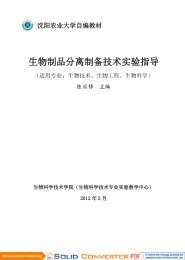

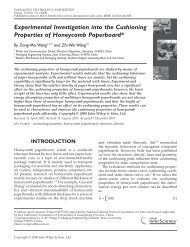
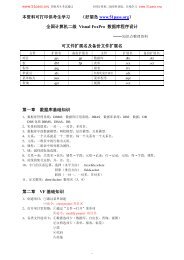
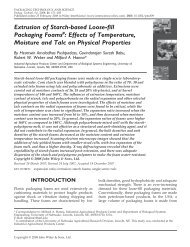
![()] 1](https://img.yumpu.com/45117883/1/190x143/-1.jpg?quality=85)
